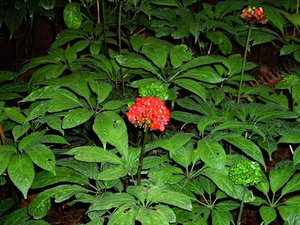
Pinyin: San Qi or Tian Qi Latin: Panax Pseudoginseng Notoginseng
Physical Characteristics
Perennial growing to 1.2m at a slow rate. It is hardy to zone 0. The flowers are hermaphrodite (have both male and female organs) The plant prefers light (sandy), medium (loamy) and heavy (clay) soils. The plant prefers acid, neutral and basic (alkaline) soils. It can grow in full shade (deep woodland) or semi-shade (light woodland). It requires moist soil.
Family
Edible Uses*
Edible Uses: Drink; Tea. The roots are chewed, used as a flavouring in liqueurs or made into a tea[183].*
Traditional Chinese Medicinal (TCM) Uses*
Analgesic; Antiinflammatory; Antiphlogistic; Antiseptic; Astringent; Cardiotonic; Diuretic; Haemostatic; Hypoglycaemic. San Qi is a fairly recent newcomer to Chinese herbalism, the first recorded usage dating from the sixteenth century. Nevertheless, it has attained an importance as a tonic medicine that supports the function of the adrenal glands, in particular the production of corticosteroids and male sex hormones. It also helps to improve blood flow through the coronary arteries, thus finding use as a treatment for arteriosclerosis, high blood pressure and angina. The roots are said to be analgesic, anti-inflammatory, antiphlogistic, antiseptic, astringent, cardiotonic, discutient, diuretic, haemostatic, hypoglycaemic, styptic, tonic and vulnerary. They are used in the treatment of contused wounds, soft tissue injuries and all kinds of bleeding, both internal and external, like haematuria, nose bleeds, haematemesis, uterine bleeding etc.*
They are also used in the treatment of coronary heart disease and angina pectoris. The roots can be applied externally as a poultice in order to help speed the healing of wounds and bruises. The root is harvested before flowering or after the seed has ripened. It is usually dried for later use. There is much confusion in literature over this plant and P. pseudo-ginseng. It is probable that the two can be used interchangeably but this has still to be confirmed. The following are the uses attributed to P. pseudo-ginseng:- The roots and the flowers are antibacterial, anti-inflammatory, antiseptic, cardiotonic, diuretic, haemostatic and hypoglycaemic. The root is used internally in the treatment of coronary heart disease and angina. The roots are also used both internally and externally in the treatment of nosebleeds, haemorrhages from the lungs, digestive tract and uterus, and injuries. The roots are harvested in the autumn, preferably from plants 6 - 7 years old, and can be used fresh or dried. The flowers are used to treat vertigo and dizziness.*
References
Sources: Panax Pseudoginseng Notoginseng San Qi or Tian Qi Plants For A Future, England 1996-2008.
This work is licensed under a Creative Commons License.
Natural dietary supplements are designed to offer the body support to promote health, harmony, balance and overall well being.*

 Get Well Natural, LLC
Get Well Natural, LLC  Kidney Function & Regeneration Health
Kidney Function & Regeneration Health  Platelet & Blood Cell Health
Platelet & Blood Cell Health  Prostate, Flow & Function Health
Prostate, Flow & Function Health  General Mind & Body Health
General Mind & Body Health  Heart, Cholesterol & Cardio Health
Heart, Cholesterol & Cardio Health  Allergy-Free Body
Allergy-Free Body  Anxiety & Stress
Anxiety & Stress  Blood Platelet Counts & Function
Blood Platelet Counts & Function  Blood Pressure Health
Blood Pressure Health  Kidney Health
Kidney Health  Immune System Health & Balance
Immune System Health & Balance  Prostate & Urinary Health Function
Prostate & Urinary Health Function  Blood Sugar Balance
Blood Sugar Balance  Cardiovascular Heart Health
Cardiovascular Heart Health  Detoxification & Healthy Cells
Detoxification & Healthy Cells  Women's Health
Women's Health  Liver Regeneration
Liver Regeneration  Pain-Free Body
Pain-Free Body  Water & Air Filtration
Water & Air Filtration 


